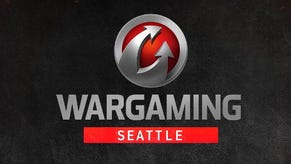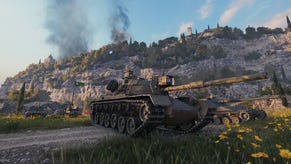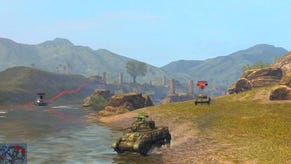An Armoured Interview: World Of Tanks
Last week I had a look at World of Tanks, and it looked pretty good, in a TANKS TANKS TANKS kind of way. Naturally I wanted to know more about the minds behind the idea, and so I had a bit of a chat with Anton Sitnikov, the Lead Designer of World Of Tanks. Broaching such wildly varied questions as ‘Why tanks?’ and ‘Why these tanks?’, it’s an interview of highs and lows, the interview equivalent of swapping out your short and thick gun barrel with something altogether longer and thinner. There’s also some stuff about being Free 2 Play, because that’s an interesting topic right now.
RPS: Why tanks? Or, more specifically, why just tanks? What was the appeal of shoving thirty great big angry hunks of metal in the same theatre of battle to duke it out?
Sitnikov: We are infatuated with military vehicles and tanks especially. Moreover, with 12-year experience in developing wargames, we know how to make armored vehicles. A Tank is the powerful steel beast associated with the roar of engines, thick armor, deadly salvos, and the smell of solar oil. And we just love all that stuff.
The choice of the concept wasn’t random. World of Tanks has solely panzers due to the gameplay requirements. Now we can see that picking a tank to be the main “character” of the game wasn’t a mistake. Moreover, tank destroyers and SPGs contribute immensely to the diversity of World of Tanks’ gameplay.
We don’t disclaim the opportunity of introducing infantry into the game in the far future. Still, we understand that it will change the concept drastically. That’s why we first want to tune up and polish the current gameplay and then we’ll be thinking on how to implement infantry without any plausible drawbacks to the game’s concept and fun.

RPS: With the slightly absurd premise of having dozens of tanks, without any infantry, fighting, what made you decide to go for the realism route in terms of the tanks themselves and the way shells penetrate and damage them?
Sitnikov: We do understand that initially the role of a tank is supporting infantry and we do understand that some might think that the game would look incomplete without platoons of troopers on battlefields. But again, World of Tanks was designed purely for applying your tank-commander skills and cooperating within a team together with vehicles of different types and classes. What we were not trying to reach is yet another Battlefield or CoH.
The cooperation between infantry and armored vehicles was the main tactics during WWII, but World of Tanks features vehicles of much greater period of time that covers not only the WWII era but also earlier and later times. This is what we call the “golden age” in tank building history. The time period we picked fits perfectly our gameplay needs, while fighting vehicles of earlier or later periods would require absolutely different gameplay.
On the other hand, a boring tank simulator is not what we were planning to reach. We haven’t blindly transported real-life characteristics of panzers into the game. We were looking for the reasonable balance between realism and gameplay for each fighting vehicle and it looks like we’ve managed to find it.

RPS: At the moment you have just Russian and German tanks, with the American tree imminent. Why did you go for those two nations first?
Sitnikov: The answer is quite obvious: first massive-scale tank battles were fought between German and Soviet forces. These two tank building schools had the most advanced technologies at the time and they contributed more than others into the tank building history of the middle of the XX century.
Following the same logic, American panzers will come just after German and Soviet ones. US armored vehicles played a great role in the later WWII battles and some of them are extremely interesting from tank engineering standpoint.
RPS: Following from that, why even bother dividing the tanks by nation at all? Did you feel it important to instill some historical context into them, rather than just having them listed by type and name, even if it was only to place them under a national flag?
Sitnikov: First off, I would like to mention that we don’t divide tanks by nations in battles. We have the battles of machines, not battles of ideologies or nations.
Dividing tanks by nations is justified historically because despite the versatility of vehicles within each tank building nation they still have their unique peculiarities and features, starting with their looks and ending up with their behavior on battlefields.
Each panzer unlocks the unit of the next level according to the technologies that led to the appearance of more technologically advanced vehicle in real life, which is, again, justified historically. We find it rather reasonable and that’s why it’s presented in World of Tanks. The case when after driving and upgrading the King Tiger a player would unlock a Soviet tank is hideously wrong from both historical and gameplay standpoints.

RPS: Your method of utilising micro-transactions could be considered somewhat questionable due to withholding the ability to create teams and play with friends from those who don’t pay. Why was this considered a paying privilege? Has it been an issue of contention within the community?
Sitnikov: Let me clarify something: in order to create a squad and play with friends within one team, a player must have a premium account. Still, this player can invite any players to his squad notwithstanding whether they pay or not. Thus, within a squad of, say, 3 players there must be only one player who has actually invested money into the game. Thereby we encourage the cooperation between non-paying and paying users which in its turn decreases the chance of conflicts between these two types of players.
Of course, we had some people within the community who were not happy with this option but we didn’t face any serious problems with it. I believe it’s because we’re trying to be loyal and don’t force people to pay for the premium account in order to join squads.
RPS: While playing the game, it seems there’s some pretty clear opinions on which tanks are best, and which nationality it’s most worth following. Do you feel there is a need to balance the tanks, or do you prefer to stick to historical accuracy?
Sitnikov: We’re studying the players’ preferences very cautiously and statistics helps us reveal flaws and tweak some tanks if required. We don’t see any significant flaws in balance now, still we can’t say that the balancing is already perfect. We are accumulating and studying tons of statistics permanently and we don’t see any fatal drawbacks (however, I can already predict some complaints on artillery in the comments to this article :) ).
Everything depends on your playing style. To put it bluntly, German panzers are good at fighting at medium and long distances while the Soviets are more effective in tense close combats. Each nation and each type of a unit provides its unique gameplay.
Here is an interesting thing to think about. When we arranged the tourney among the Russian players, two teams staffed with the German vehicles made it to the finals. While the CBT tourney for the Western audience featured two teams with the Soviet panzers in the finals. It may sound funny, but while Russian players are complaining about overpowered German panzers, we keep hearing the same complaints from the western beta testers about Soviet machinery.
According to all these facts and our statistics we can state there’s no dominance of either of the nations. I believe that after implementing the team mode this kind of complaints will cease gradually.

RPS: As you come out of the beta phase, how do you see yourselves moving forward?
Sitnikov: We’ve got loads of work now and I’m afraid that times will become even tougher for us when the closed beta is over. Now we are totally into the American tanks line which is 99% complete. Our players will be able to give a try to the Team mode in the open beta, clan wars are on the way as well. Along with new maps, new panzers and nations such as France will come.
Historic events are coming soon and we are putting the very strong emphasis on this mode. Another important point we are thinking of implementing is the in-game secondary market where players can buy and sell different stuff including gold.
RPS: It seems like the most sensible route to take with Free 2 Play games is one of persistence, keeping the players playing, and paying. Beyond what is already in place, do you feel the need to push that aspect further, whether it be with providing context to the battles with territory control, or making the current level and tier system even more expansive?
Sitnikov: Our community can be divided into two primary audiences: hardcore players and more casual ones. Both these audiences will find lots of features that the game has to offer to keep them playing.
Hardcore players are longing for the social part and clan wars, which is natural. And we will give it to them with the upcoming Clan Wars with endless opportunities to show themselves during the fights for the global domination.
At the same time, more casual players don’t actually need it. These players prefer to have up to 10 battles after hard working day that helps them let off steam and simply have some fun. They will also not get bored with WoT as our tech trees will be expanded gradually with new vehicles and nations offering different playing styles.
There are some specific modes that we’ll be implementing just for pure fun like Football matches on tanks or Survival mode where you have to repel attacks of AI-controlled zombie tanks from all directions.

RPS: Do you feel that with a niche concept like World Of Tanks, it’s a benefit to be free to play and allow players to have a go with the game before committing themselves by spending? Do you think it’s a good route for niche games, and wargames in particularly, to head down?
Sitnikov: To be honest, I can’t call our game an absolutely niche project. Yes, initially it was planned to be targeted at tank enthusiasts and history buffs, but as the time goes we see that we have a very mixed and diverse community that keeps growing rapidly. As World of Tanks depicts a combination of multiple genres, apart from our initially targeted audience, we have players coming from shooters, strategies and RPGs. World of Tanks makes every player feel like a little boy (or girl) longing for commanding a tank and kicking some butt. This is why our community is that versatile.
Now back to F2P model. Making a PvP game is a very risky endeavor these times. Free2Play is the right choice when you can’t predict how many people will actually play your game. When counting on subscription you can’t be sure that you’ll accumulate a really big community that will be interested in playing with each other, while F2P is a very flexible model that helps you work effectively with both huge and small communities.
Talking about World of Tanks, we think that we could reach that happy medium between F2P and Pay-to-Play. The premium account, the main source of revenue for the project, represents a kind of a voluntary subscription. However, let me remind you that premium accounts don’t give any advantages in battles, it only helps you advance a bit faster giving 50% boost to credits and experience you gain after each battle. As a result, it’s only your skills that make you a great player, not your wallet. And we think it’s fair.
Talking about other niche projects and wargames… Well, every game is unique and even using Free-2-Play model can mean dozens and hundreds of methods of how actually make money from your project. But we do really think that it’s the fairest paying model on the market so far as it gives the opportunity to try the game out before starting paying.
RPS: Why do you think there’s been a sudden swell of free to play games coming out? Is it just the availability of broadband, or is it more a general attitude towards more esoteric games in the PC gaming sphere?
Sitnikov: Free2Play has already showed great results in Asia and Russia, and now we can see that highly acknowledged Western online projects picked Free2Play as their primary paying model. We think that’s a great tendency as Free2Play is no longer associated with cheap and low-quality games. Free2Play gives developers and publishers flexibility and helps them be more competitive on the fierce and oversaturated market of online games.
We see rapid growth of niche PC games and we like this tendency. A big number of more esoteric games automatically provides bigger choice for a player who can pick exactly the game they really like. While Free2Play give players the chance to try the game and play it for a long time without spending a penny and doesn’t force them to pay for the features they dislike. In our opinion, Free2Play is a fair and flexible model that turned out to be very efficient.
RPS: Thanks for your time.









